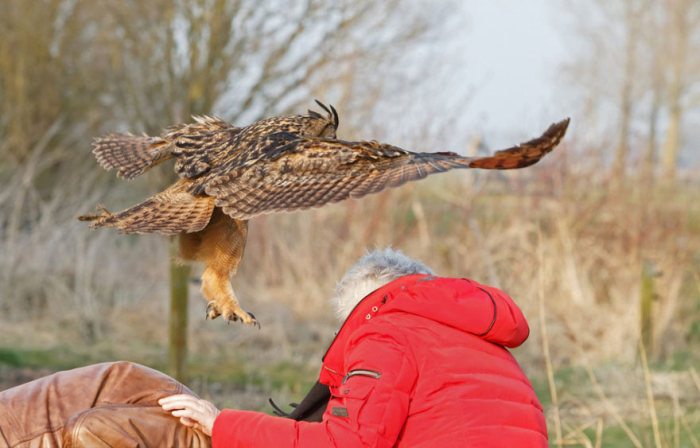|
|
Eurasian Eagle Owl Lands On A Head
|
The Eurasian eagle-owl is a member of the genus Bubo, which may include either 22 or 25 extant species. Almost all the larger owl species in the world today are included in Bubo. Based on an extensive fossil record and a central distribution of extant species on that continent, the Bubo appears to have evolved into existence in Africa, although early radiations seem to branch from southern Asia as well. Two genera belonging to the scops owls complex, the giant scops owls (Otus gurneyi) found in Asia and the Ptilopsis or the white-faced scops owl found in Africa, although firmly ensconced in the scops owl group, appear to share some characteristics with the eagle-owls. The Strix is also related to the Bubo and is considered a "sister complex", with the Pulsatrix possibly being intermediate between the two. The Eurasian eagle-owl appears to represent an expansion of the Bubo genus into the Eurasian continent. A few of the other species of Bubo seem to have been derived from the Eurasian eagle-owl, making it a "paraspecies", or they at least share a relatively recent common ancestor. The pharaoh eagle-owl, distributed in the Arabian Peninsula and sections of the Sahara Desert through North Africa where rocky outcrops are found, was until recently considered a subspecies of Eurasian eagle-owl. It appears that the pharaoh eagle-owl differs about 3.8% in mitochondrial DNA from the Eurasian eagle-owl, well past the minimum genetic difference to differentiate species of 1.5%. Smaller and paler than Eurasian eagle-owls, the pharaoh can also be considered a distinct species largely due to its higher pitched and more descending call and the observation that Eurasian eagle-owls formerly found in Morocco (B. b. hispanus) apparently did not breed with the co-existing pharaoh eagle-owls. On the contrary, the race still found together with the pharaoh in the wild (B. b. interpositus) in the central Middle East has been found to interbreed in the wild with the pharaoh eagle-owls, although genetical materials have indicated interpositus may itself be a distinct species from the Eurasian eagle-owl as it differs from nominate subspecies eagle-owls by 2.8% in mitochondrial DNA. The Indian eagle owl was also considered a subspecies of Eurasian eagle-owl until recently, however its smaller size, distinct voice (more clipped and high-pitched than Eurasians) and the fact that it is largely allopatric in distribution (filing out the Indian subcontinent) with Eurasian eagle-owl races has led to it being considered a distinct species. The mitochondrial DNA of the Indian species also appears considerably distinct from the Eurasian species. The cape eagle-owl (B. capensis) appears to represent a return of this genetic line back into the African continent, where it leads a lifestyle similar to northern eagle-owls albeit far to the south. Another offshoot of the northern Bubo group is the snowy owl. It appears to have separated from other Bubo at least 4 million years ago.
The fourth and most famous derivation of the evolutionary line that includes the Eurasian eagle-owl is the great horned owl, which appears to have been the result of primitive eagle-owls spreading into North America. It has been stated that the great horned owls and Eurasian eagle-owls are barely distinct as species, with a similar level of divergence in their plumages as the Eurasian and North American representations of the great grey owl or the long-eared owl. However, there are more outward physical differences between the great horned owl and the Eurasian eagle-owl than in those two examples, including a great size difference favoring the Eurasian species, the horned owl’s horizontal rather than vertical underside barring, yellow rather than orange eyes and a much strong black bracket to the facial disc, not to mention a number of differences in their reproductive behaviour and distinctive voices. Furthermore, genetic research has revealed that snowy owls are more closely related to the great horned owl than are Eurasian eagle-owls. The most closely related species beyond the pharaoh, Indian and cape eagle-owls to the Eurasian eagle-owl is the smaller, less powerful and African spotted eagle-owl (B. africanus), which was likely to have divided from the line before they radiated away from Africa. Somehow, genetic materials indicate the spotted eagle-owl appears to share a more recent ancestor with the Indian eagle-owl than with the Eurasian eagle-owl or even the sympatric cape eagle-owl. Eurasian eagle-owls in captivity have produced apparently healthy hybrids with both the Indian eagle-owl and the great horned owl. The pharaoh, Indian and cape eagle-owls and great horned owl are all broadly similar in size to each other but all are considerably smaller than the Eurasian eagle-owl, which averages at least 15–30% larger in linear dimensions and 30–50% larger in body mass than these other related species, possibly as the eagle-owls adapted to warmer climates and smaller prey. However, fossils from south France have indicated that during the Middle Pleistocene, Eurasian eagle-owls (this paleo-subspecies given the name B. b. davidi) were larger than they are today. Even larger than those found in Azerbaijan and in Caucasus (either B. b. bignadensis or B. bignadensis), which were deemed to date to the Late Pleistocene. About a dozen subspecies are recognized today.
|
|









